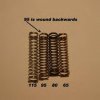I'm rebuilding the carb on the 02 GTI with a 717 engine. This is a single carb engine. Seadoosource calls for a 2.0 needle with a popoff psi of 36-40. The carb is BN-40I-38-48. Part diagrams call for spring 270500428.
However, all of the charts that I can find indicate that with a 2.0 needle, even the 115 gram gold spring would yield a popoff psi of 32 psi.
There is no spring that will yield the higher popoff psi called for on seadoosource.
What am I missing?
If everything works out as planned and the popoff psi is 32, is that ok to stay with? An option would be to switch to a 1.5 and a black spring to yield the expected 38 psi popoff.
I'm going to put it together and test it, but I was hoping to have a bit more confidence in doing it correctly the first time.
thanks
However, all of the charts that I can find indicate that with a 2.0 needle, even the 115 gram gold spring would yield a popoff psi of 32 psi.
There is no spring that will yield the higher popoff psi called for on seadoosource.
What am I missing?
If everything works out as planned and the popoff psi is 32, is that ok to stay with? An option would be to switch to a 1.5 and a black spring to yield the expected 38 psi popoff.
I'm going to put it together and test it, but I was hoping to have a bit more confidence in doing it correctly the first time.
thanks





